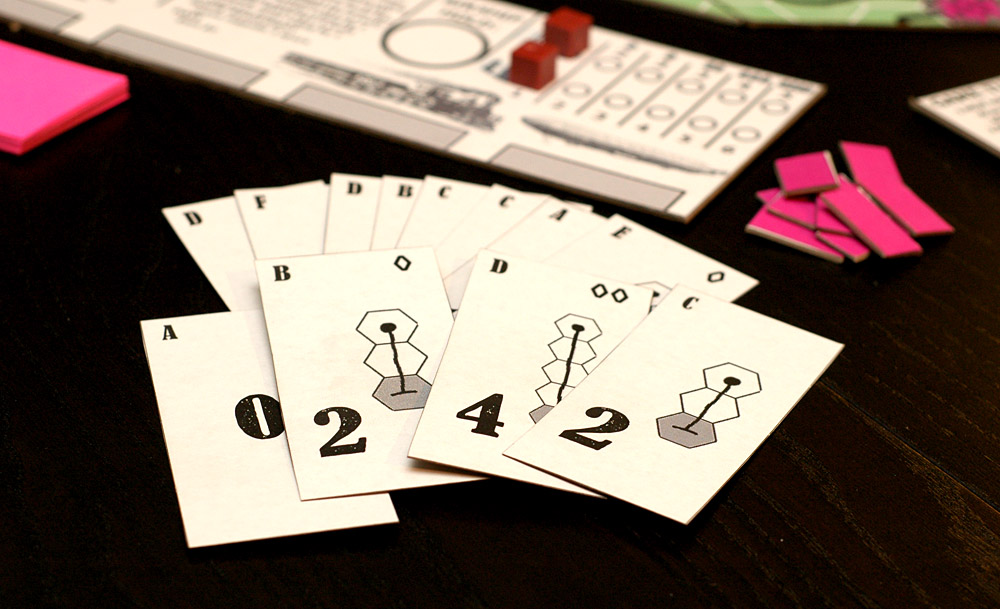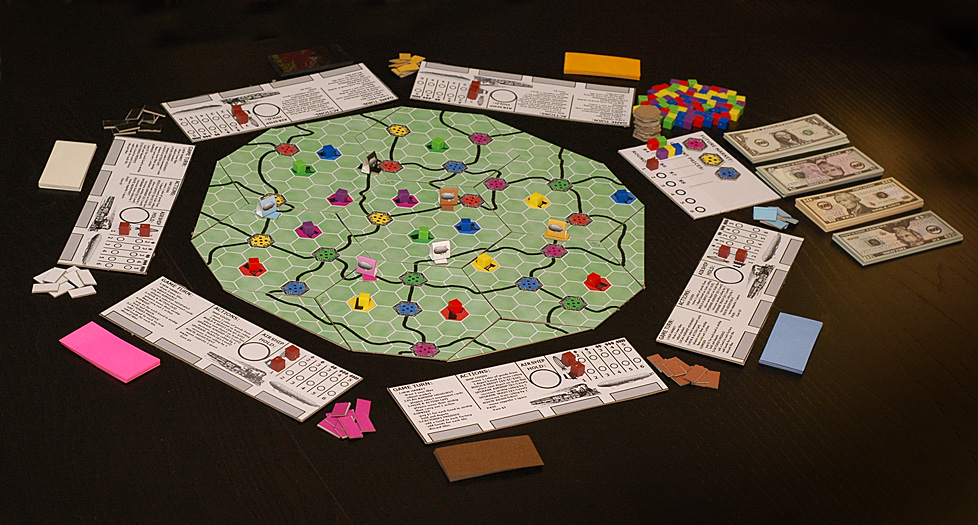Kickstarter Preview: Kings of Air & Steam
 From time to time, one geek-centric genre trend becomes fashionable; subsequently, the masses yearn and, thus, the creators provide – often in bulk. The latest genre du jour seems to be steampunk – that mixture of wild, cog-driven contraptions and Victorian sensibilities. Of this genre I am not only a fan, but a bit of a connoisseur; I spent many a youthful day glued to the TV watching James West foil the bad guys’ plans with the use of one of Artemus Gordon’s goofy gadgets long before anyone had ever coined the term steampunk. All you dear readers also know by now that I am a sucker for zeppelins, as well. And, so, it was with great enthusiasm that I accepted the honor of reviewing the prototype of Tasty Minstrel Games’ newest Kickstarter project, Kings of Air & Steam. After playing a few times, I only wish that I could say that the enthusiasm remained.
From time to time, one geek-centric genre trend becomes fashionable; subsequently, the masses yearn and, thus, the creators provide – often in bulk. The latest genre du jour seems to be steampunk – that mixture of wild, cog-driven contraptions and Victorian sensibilities. Of this genre I am not only a fan, but a bit of a connoisseur; I spent many a youthful day glued to the TV watching James West foil the bad guys’ plans with the use of one of Artemus Gordon’s goofy gadgets long before anyone had ever coined the term steampunk. All you dear readers also know by now that I am a sucker for zeppelins, as well. And, so, it was with great enthusiasm that I accepted the honor of reviewing the prototype of Tasty Minstrel Games’ newest Kickstarter project, Kings of Air & Steam. After playing a few times, I only wish that I could say that the enthusiasm remained.
In Kings of Air & Steam, behind that steampunk facade, past the zeppelins and the whimsical Cappel characters, lies the heart of a train game. I don’t mean Ticket to Ride; I mean meaty affairs like Age of Steam and Railways of the World, and those 18XX games that garner a very grognard-like following. For those of you who are unacquainted with such games, the typical goal is to build the most efficient and economical system of tracks, trains, depots and the like in order to ship goods from one part of a map to a city that demands that particular good in another part of the map. There are usually various economic systems in place to regulate the demand and standing price for goods, and these can range from company stocks to loans to straight-up cash for scrap. To some gamers, that synopsis will no doubt prompt a flick of the snooze button on their alarm clocks, but to other gamers who are bitten by the railway bug, a good train game can satisfy like no other.
Kings of Air & Steam definitely has trains – that’d be the steam part. But Kings of Air & Steam mixes up the traditional train game aesthetic with the addition of airships. Instead of being confined to the typical “buy track, lay track, move train, grab goods, ship goods” routine of most train games, players use their airships to zip around the board, grab goods from factories and take them back to depots that can be built on the existing tracks. Players can then use their trains to ship said goods and earn cash for their efforts.
In a traditional train game, players are limited to the tracks that they, and others, build on subsequent turns. In Kings of Air & Steam, the tracks are present from the beginning, and the airships can travel most anywhere to grab the right goods. Since they are unfettered by tracks, that means there can be a lot of competition – and a fair bit of punkery – when getting goods. The freedom that the airships afford is a novel mechanic that is tied in well with the theme. However, after a few plays, it will become obvious to anyone who has played a train game before that the strategy of building the right track at the right time to stymie opponents and gain the upper hand is woefully missing.
 Another key mechanic to Kings of Air & Steam is in the movement planning stage. Every player has a hand of cards with various airship movement allowances. There are four turns to a round, and players must choose which four cards, and in which turn order, they would like to play during the round. Some cards have a diamond rating, which limits card usage until players upgrade their airships. This is a pretty nifty mechanic that forces difficult decisions, and helps to keep players from running all over the board. After movement has been decided, players reveal those cards for turn 1; the cards have letter codes that signify which player is first to move. That player takes their movement, and one action (such as ship a good, upgrade an airship/train, build a depot), then play passes to the player with the next logical letter code. After all players have taken their movement and actions, cards are revealed for the next turn in the round. This continues until the end of the fourth turn, and then the process begins again.
Another key mechanic to Kings of Air & Steam is in the movement planning stage. Every player has a hand of cards with various airship movement allowances. There are four turns to a round, and players must choose which four cards, and in which turn order, they would like to play during the round. Some cards have a diamond rating, which limits card usage until players upgrade their airships. This is a pretty nifty mechanic that forces difficult decisions, and helps to keep players from running all over the board. After movement has been decided, players reveal those cards for turn 1; the cards have letter codes that signify which player is first to move. That player takes their movement, and one action (such as ship a good, upgrade an airship/train, build a depot), then play passes to the player with the next logical letter code. After all players have taken their movement and actions, cards are revealed for the next turn in the round. This continues until the end of the fourth turn, and then the process begins again.
 Much of the rest of the game features streamlined versions of many train game staples and mechanics. There is a market track that uses random tile pulls to set the demand and price for goods; trains are upgraded in order to allow them to ship goods across multiple spans of tracks; players can pay opponents a small fee to ship goods along tracks that contain that opponent’s depot; and fees are paid to the bank when players are unable to deliver goods at the end of the round and are forced to store them on depots or in airship holds.
Much of the rest of the game features streamlined versions of many train game staples and mechanics. There is a market track that uses random tile pulls to set the demand and price for goods; trains are upgraded in order to allow them to ship goods across multiple spans of tracks; players can pay opponents a small fee to ship goods along tracks that contain that opponent’s depot; and fees are paid to the bank when players are unable to deliver goods at the end of the round and are forced to store them on depots or in airship holds.
 Unlike many of Tasty Minstrel Games’ titles (Belfort, Eminent Domain and Homesteaders are all wonderful), I’m torn on Kings of Air & Steam. The theme is directly in my wheelhouse, and the whimsical world that Josh Cappel is weaving (as usual) is captivating. I’m a big fan of trains, train games, and, obviously, zeppelins. However, playing the prototype of Kings of Air & Steam didn’t leave me, or any of the other players involved in multiple sessions, feeling all of the excitement that the premise promises. The modular board – although guaranteeing lots of replay value – seemed almost a little too loose with any number of players, guaranteeing that one player in the batch could access, nab and ship goods nearly-unchallenged. The movement planning stage is definitely key to the uniqueness of the gameplay, but it also has an unsuspected negative impact in games of more than four players; the last game of six dragged on for 2 hours, and by the end of round 4, most of the players were ready to call the game – and those same players also wished their airships came equipped with weapons. This could be an immersion issue – the prototype, while serviceable, doesn’t engage as well as the final game inevitably will – or it could be the lack of the variable player powers promised in the final version. I, and many other playtesters, were denied copies of the characters as they were still under development. I am only left wondering if the game would have been vastly improved and hastened with just that little extra bit of personality.
Unlike many of Tasty Minstrel Games’ titles (Belfort, Eminent Domain and Homesteaders are all wonderful), I’m torn on Kings of Air & Steam. The theme is directly in my wheelhouse, and the whimsical world that Josh Cappel is weaving (as usual) is captivating. I’m a big fan of trains, train games, and, obviously, zeppelins. However, playing the prototype of Kings of Air & Steam didn’t leave me, or any of the other players involved in multiple sessions, feeling all of the excitement that the premise promises. The modular board – although guaranteeing lots of replay value – seemed almost a little too loose with any number of players, guaranteeing that one player in the batch could access, nab and ship goods nearly-unchallenged. The movement planning stage is definitely key to the uniqueness of the gameplay, but it also has an unsuspected negative impact in games of more than four players; the last game of six dragged on for 2 hours, and by the end of round 4, most of the players were ready to call the game – and those same players also wished their airships came equipped with weapons. This could be an immersion issue – the prototype, while serviceable, doesn’t engage as well as the final game inevitably will – or it could be the lack of the variable player powers promised in the final version. I, and many other playtesters, were denied copies of the characters as they were still under development. I am only left wondering if the game would have been vastly improved and hastened with just that little extra bit of personality.
Still, despite the drawbacks, I can see Kings of Air & Steam becoming a nice, casual gateway toward meatier build-and-ship boxes on the game shelf, or as a nice departure for those heartier gamers who are drawn to the aspects of train games but don’t quite feel that track lust that hardcore rail barons do. For me, I will remain excited to see what Josh Cappel has in store for the already-established steampunk world of Kings of Air & Steam. As for the game itself, I may just feel compelled to leave it sitting at the station.
Related posts:
- Expanding Space – An Alien Frontiers: Factions Preview
- Kickstarter Quick-look: Super Showdown
- I’ve Been Drinking on the Railroad – A TransEuropa Review
- The State of Games, Episode 19 – The One About the Kickstarter Bubble
- Kickstarter Profiles, Part 2: Startup Fever



I’m sorry I missed the play testing at MACE. Kind of. I too am a fan of steampunk and have high hopes for this game. I was not aware that this prototype lacked the player personalities/special abilities. That’s sad as that is one of the unique points that TMG is touting for the game. Seems like they rushed this out to coinside with the Kickstarter. And that may have be hasty as it appears to have affected your opinion of the game. It’s like you’re not playing the real game. 🙁
I’m still interested in playing as I like train games too. Hopefully TMG will send you the characters soon and you can get a real game in.
I tried out the prototype as well, and actually enjoyed it — but I wonder if that’s because (1) I’m not as invested in steampunk so the fact that the prototype didn’t have a lot of the finished graphics and polish on it didn’t bother me and (2) I haven’t played too many other train games so a lot of the mechanics are new to me. Also, I’m a fan of Wings of War with the simultaneous movement selection and I liked the challenge of changing tactics mid-stream when somebody nabs your goods but you’ve already chosen your next three movements.
Certainly the addition of player characters will add a lot to the game that isn’t there right now, but there was enough that I enjoyed it. However, I played mostly 3-player games, which didn’t drag on for quite as long and the smaller board is actually better balanced for that many players.
And, Tom, you’re right: you AREN’T playing the real game, just the skeleton of one. It was enough to hook me, though. But I could see that if I’ve played a lot of other train games that maybe it would have lost some of its novelty.
I’m glad you had a good game Jonathan. That ‘change in mid-stream’ thing is neat. I have every confidence that TMG will make a great game. Their track record so far is very good.